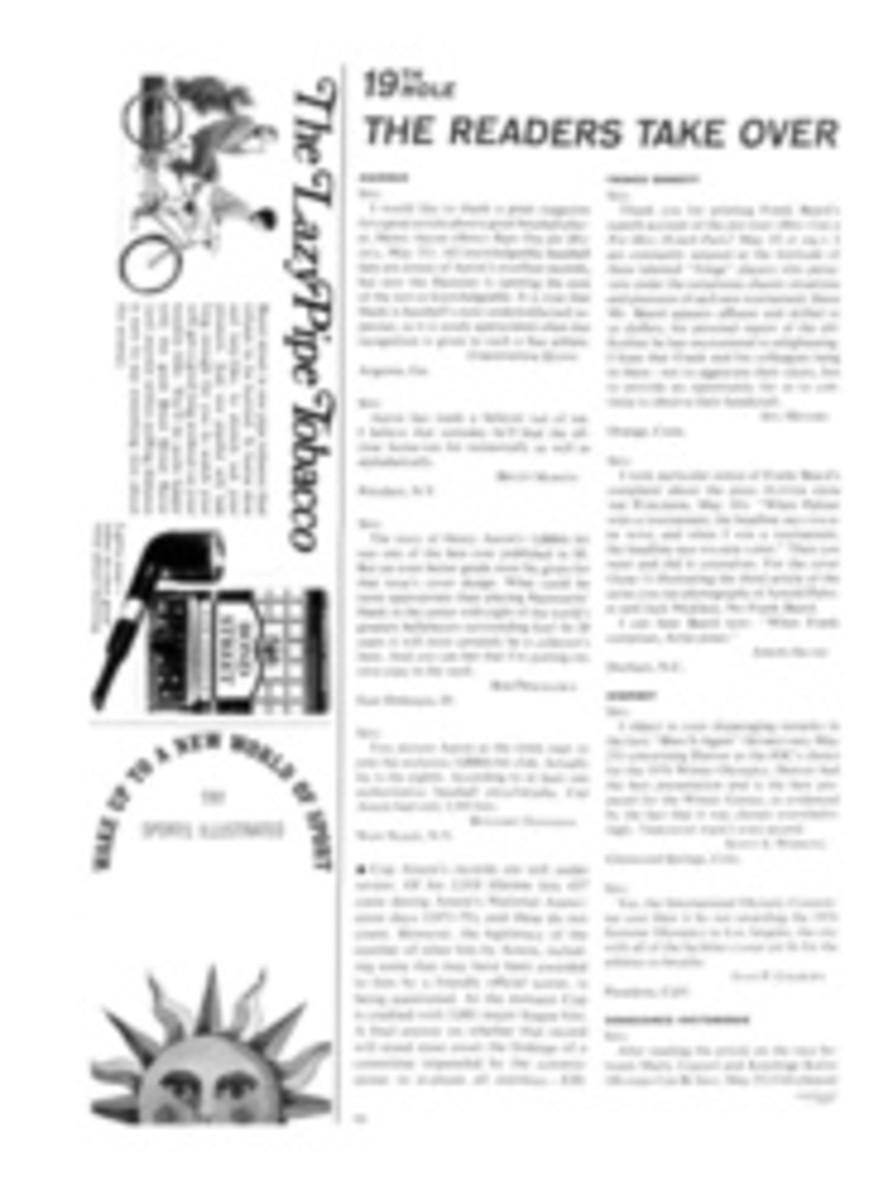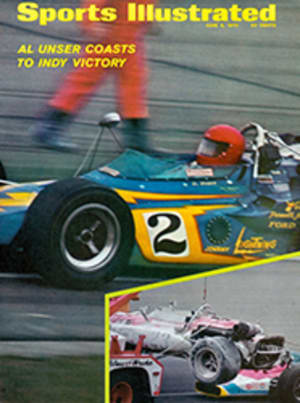
Spin-cast flies—toothpaste tubes and wire
Last summer a French-Canadian guide named Emile Carriere took a client to a good fishing lake in Quebec and ran into unusually bad luck. He caught 17 trout and his client did not catch any. On their next trip Carriere's luck was even worse. He hauled in 22 trout. "Again my client caught none," said Carriere. "This is not good, for a guide to catch all the fish. I think I have to do something quick or I will not be a guide much longer."
What he did, very quickly, was improvise a fly that could be cast on his client's spinning gear. Carriere reasoned that on a clear day, in clear water, fish are afraid to come up. They stay deep, and it is necessary to send a fly down to them. Carriere is an expert flycaster who has been fly-fishing for most of his 48 years. The lake was about 30 feet deep, and Carriere was fishing the bottom, casting as far as he could, letting the fly go way down and then retrieving slowly. His client was a spin fisherman. He had to use plugs, spoons, wobblers and various lures that are imitations of grosser aquatic diet than flies.
With unlimited time Carriere might have been able to teach his client fly casting. But "no man is born an artist or an angler," said Izaak Walton, and anyone who has ever struggled to shoot a recalcitrant line through the guides of a nine-foot rod will readily agree. One does not learn fly-fishing in a week or in a season, and certainly not in a single morning on a lake. Some fishermen never learn in a lifetime. That is one reason why spin fishing has become popular, not only with beginners and the impatient, but with those who, like Carriere's undemanding client, do not have much time to devote to their sport.
Carriere's first spinning fly was fashioned then and there on the shore of Lake Repose. He attached one of his own wet flies to a monofilament leader. This leader he fastened with swivels to a cut-down steel leader that he weighted and equipped with a spinner. The result was unconventional, but when his client cast it with his spinning gear Carriere's luck changed: his client caught a fish. Then he caught more. Carriere was still in business, but he was also starting a new career. For the next several months he experimented with leader-and-weight combinations, searching for the right link between fly and spinning tackle.
He first conferred with a friend in Montreal who was trying to weight flies with strips cut from toothpaste tubes. (Weighted flies have been tried for a long time, with indifferent success.) The idea was right but the method and materials were wrong. Next Carriere tried adding small machine weights in front of the hook eye and at various intervals on fine wire leader. These carried the fly out but somehow did not fool enough fish. Then Carriere experimented with split shot, fastening it to the hook shaft before tying the fly. The result was a bulging, bunched-up body that would not tie evenly. Carriere also tried putting drops of hot soldering lead on the hook shafts. But because hooks are treated to prevent rust, each shaft had to be filed for the solder to adhere. The secret, he was convinced, was in weighting the hook, not the leader, but the weight had to be less bulky than shot and easier to apply than solder.
He did much of his experimenting in a small wooden shed at Gray Rocks Inn, St. Jovite in Quebec's Laurentian Mountains, where in winter he sells lift tickets at the ski slope. Carriere began work at Gray Rocks at the age of 10 as a caddie and grounds boy, and while he has been a shovel operator, construction worker, road builder, contractor, carpenter and cook (as well as a hunting and fishing guide), he returned to Gray Rocks between these varied jobs. During the winter Carriere sat in his four-by-seven-foot shed with little to do, since most of the skiers at Gray Rocks are on special ski-week trips and have no reason to stop at the ticket booth.
"In that caboose there I had all the time in the world to think," Carriere said. "All winter I thought about ways to weight that fly for spinning. Every day I tried new ways. Every day I bring something else to the shed and I sit there and experiment. Something has to work, I tell myself. I bought up bits and pieces of everything. Finally I tried wire. The first wire I used was too thick. It made the body too big. But it wrapped on evenly. I went through all the stores in St. Jovite buying every kind of thin wire I could find. Then in one store I found a card of [1/32]" soldering wire. It was just what I had been looking for."
Carriere wrapped the wire around the shaft of the hook exactly as if he were wrapping it with silk. When it was completely wrapped, the hook was weighted uniformly and smoothly. He then tied his fly pattern exactly as he would on a bare hook.
Carriere's largest flies are tied on No. 3/0 hooks, which he recommends for salmon, bass, walleye, pike and gray and speckled trout. "I myself prefer the bigger hooks," he says. "Then you leave the little fish to grow up. It's a pleasure to let the small ones go by and to take the big ones only." For anglers who cannot be as selective as those who fish Quebec's abundant waters Carriere is also producing flies on hook sizes down to No. 4 for½-to one-pound fish. He will tie a No. 6 hook on request, but he considers the light line that such a small hook requires to be impractical for most fishing.
Currently he makes spinning flies in 12 standard patterns: Yellow Sally, Black Gnat, Mickey Finn, Green Ghost, Black and White, Parmachene Belle, Dark Montreal, Muddler Minnow, McGinty, Black Ghost, Grey Squirrel and Alaska Mary Ann. These are suitable for just about any fish or fishing conditions. He ties them either with a small wobbler or without, offering the choice of a fly with built-in action or one that must be worked by the angler. He sells his spinning flies for $1.25 each or $15 for a card of the 12 patterns mentioned. The card comes with two leaders—one wire, one nylon—with spinning disks, swivels and snaps.
Most of Carriere's flies were tied in a small workshop beneath the restaurant, La Buche, he owned in St. Jovite. His wife Marietta did the cooking there and his daughters waited on tables. On a good day, when he was not disturbed and the restaurant business was slow, Carriere could turn out four or five dozen spinning flies at one sitting, first cutting the feathers, hair and furs for many flies of the same pattern. Carded chenille hung in multicolored rows above his worktable. Hundreds of hooks, swivels, snaps, weights and spinners filled neat trays of baby-food jars. Heavy bobbins of three-ply nylon (which he uses instead of conventional floss or silk) were pegged along one wall.
Carriere's workmanship is beautiful. His big, heavy-knuckled hands, contrasting with the delicate creations they produce, move swiftly over the vise. In minutes the bare hook is transformed into a brilliant and beautiful creature. He holds it up to the late afternoon light coming in through a transom, near the ceiling in his workshop. "That's what the fish sees," he says. "The fish, he's always looking up from the bottom. That's the way you want to look at a fly—the way a fish sees it."
Until recently Carriere's only sales outlet was his restaurant, and that was virtually no outlet at all. Route 11, which runs outside, is not exactly the Los Angeles Freeway. Nevertheless, almost every sale he has made to date has produced several more. Lately his mailbox has begun to bulge with reorders from skiers who bought his flies last winter and have now had a chance to use them. A few of his flies found their way to Abercrombie & Fitch and to Tom Kat Sporting Goods in Mahopac, N.Y. Both stores placed orders.
Business, in fact, has been so brisk that Carriere sold his restaurant the other day and is now thinking of training a force to tie spinning flies. "Not assembly line, with one person doing the same thing over and over," he says, "but individually, so each person's work can be appreciated. There's real pride in making a fly that looks good."
Obviously, Emile Carriere's spinning flies look good. Everywhere they have been used the fish have loved them.
PHOTO

